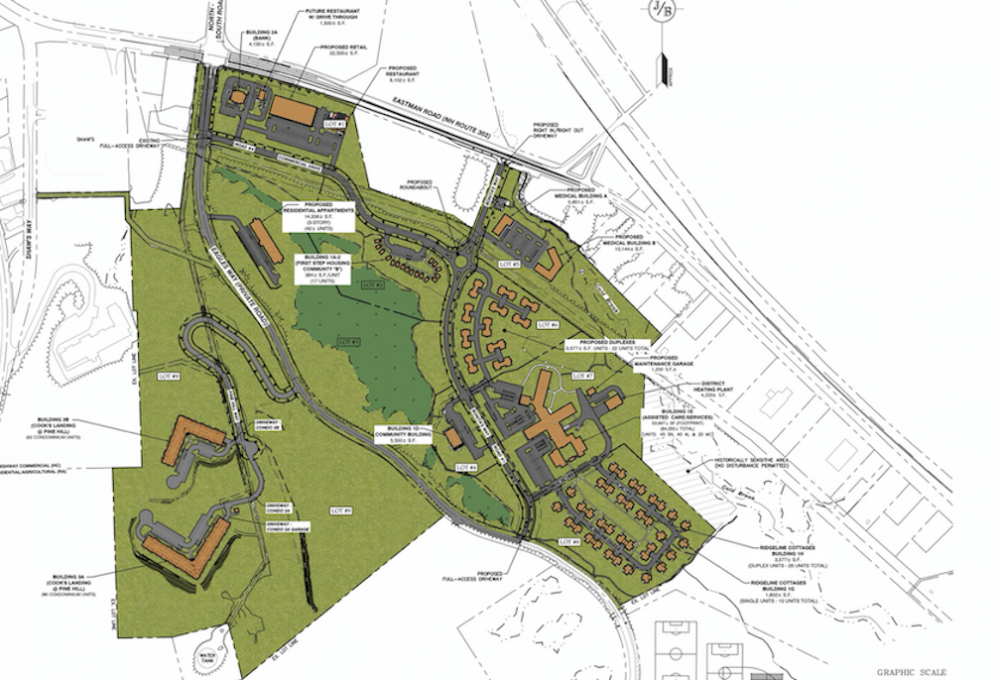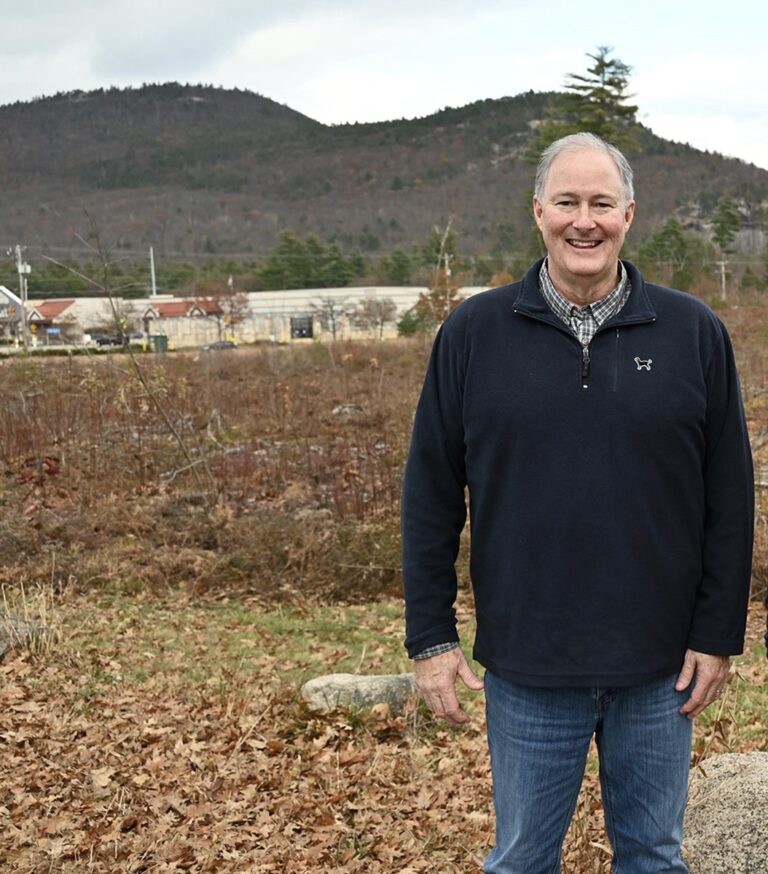
Ridgeline Community in North Conway is expected to include a range of living options, from affordable units and age-restricted cottages to ski condos and assisted living. The project also includes a biomass plant, commercial sites, and a memory care unit. (Courtesy)
Aging experts would like housing developers to keep this in mind: Aging is not defined by age, and housing options for older people need rethinking.
“When I think of senior housing, the typologies that are out there, it’s almost like we’re stuck in a time warp,” said Elizabeth White, founder of NUUAge Coliving, a Washington, D.C.-based firm that is developing shared housing for older people on moderate incomes. “We’re stuck in like 1935 when life expectancy was 62.”
Speaking to reporters at Columbia University’s Age Boom Academy in October, White noted that many people are working or living active lives into their 70s and 80s. “We’re not building housing that is responsive to this sort of contemporary older adult who is not (that) grandmother.”
Joe Hogan aims to meet that challenge with Ridgeline Community, his new mixed-use development in North Conway that will have housing ranging from cottages for people age 55 and older, ski condos, and affordable units to assisted-living and memory-care facilities.
“They’re going to be young and old,” Hogan said. “Some of the young people like the idea that there will be an assisted-living and a memory-care facility if they need it at some point down the road.”
The 126-acre site will also have medical offices, commercial businesses, affordable housing, and a biomass plant that will heat many of the buildings and the sidewalks, keeping them clear of snow and ice. He expects to begin site work in January.
The mixed-use model helped Hogan secure $3 million in state grants for the affordable housing and $1.4 million in federal money for the biomass plant, but the combination of housing, services, and amenities will also create new options for people who want to age in place in the northern part of the state where the region’s shopping, dining, and recreation opportunities, from skiing, hiking, and kayaking, are a draw.
“We need housing inventory like everyone else does,” said Kathy Bennett, whose marketing firm in Center Conway specializes in tourism and health care. “But we need senior housing. Baby boomers are aging and we have a lot of interest.”
Between 2010 and 2020, the population of Carroll County, which includes North Conway, grew 4.8 percent, more than the state average, according to the 2020 census. The county has the state’s highest median age of about 52, according to the Carsey School of Public Policy at the University of New Hampshire. Coos County is next at about 48.
Hogan’s intergenerational approach to housing is something aging experts are encouraging.
“I hear people saying to me, ‘I don’t want to be on an island of old people,’” said White. She developed her cohousing model with a couple of questions in mind. “Could you nudge behavior that would help people stay out of assisted living? Could you address some of the isolation and loneliness issues by having people live in a shared space?”
In an advisory earlier this year, U.S. Surgeon General Dr. Vivek H. Murthy called the country’s increasing social isolation and loneliness an epidemic with consequences for communities and individuals.
Social isolation among older people has been linked to an increased risk of health problems and diseases such as dementia, hypertension, depression, and self-harm. It accounts for $6.7 billion in excess Medicare spending, he wrote. Housing can have an impact, for better or worse.
“Our drive towards autonomy and independence has actually taken out of the built environment opportunities for connection and cohesion,” said Linda Fried, director of Columbia University’s Age Boom Academy. “How we think about designing future housing that includes public spaces both indoors and outdoors, that supports connection and cohesion, which is critical to well-being and health has to be an essential part of building housing that supports people’s needs.”
Hogan is mindful of creating a space to bring people of different ages together with options that could include indoor pickleball courts, a tennis court, a lounge with food options, or a clubhouse.
His plans are similar to a group of developers aiming to create a mixed-use, intergenerational community in Laconia on state-owned land that formerly housed the Laconia State School and a prison. That project, Legacy at Laconia, isn’t as far along as Hogan’s.
The state anticipates closing its $21.5 million land deal with the Legacy team on Jan. 15, and the estimated five-year plan will require significant infrastructure work, including water and sewer, before the team can erect housing, an assisted-living facility, and a hotel.

Joe Hogan is developing Ridgeline Community, a new mixed-use development in North Conway. (Courtesy)
A career path shaped by need
Hogan comes to his project with decades of experience building and running long-term care facilities in Maine.
It began with an internship at the Veterans Administration in 1982, where Hogan focused on health care administration. He was planning to pursue a graduate degree when the owner of Clover Health Care, a retirement and assisted-living facility in Auburn, Maine, offered Hogan a job.
He saw the organization through multiple expansions. Each addition responded to a demand for more housing that would allow someone to live independently in a community setting that offered the services they’d need as they aged. That ranged from housekeeping to skilled nursing to memory care.
Hogan went on to create similar facilities in Topsham and Gorham, Maine. A York Harbor, Maine, woman living in the Gorham facility talked the place up so much to former neighbors that several approached Hogan with a request.
“One day in walks a local minister, a local banker, and some other civic-minded people from the town of York Harbor, and they said, ‘Well, instead of us sending our elderly folks up to you, why don’t you guys come down here and build a place?’” Hogan said. “Long story short, we developed what’s known as the Sentry Hill retirement community.”
That was followed by developments in Orono and Kittery, Maine. Hogan and his two children continue to operate the facilities under his company, Continuum Health Care.
Hogan first looked at the North Conway property in the mid-2000s. The Great Recession of 2008 put the plan on hold, he said. As the economy improved, he and the landowner resumed negotiations. He bought the land a month ago.
“In January, it will be 41 years, and I’m still in the business,” Hogan said
Finding the right balance for mixed-use projects
The town of York had to tweak its zoning regulations to allow Hogan to build a retirement community in York Harbor. His mixed-use project would require a zoning rewrite in many New Hampshire communities but not North Conway because it is one of the state’s 147 communities that allow mixed-use development, according to the Office of Planning and Development at the state Department of Business and Economic Affairs.
Noah Hodgetts, principal planner at the agency, said mixed-use projects are increasingly including housing because there is such a scarcity of it in the state. The approach is one of many the agency covers in its NH Housing Toolbox, a 150-page guide released this year on how to use zoning and planning to increase housing in the state.
“In order to make a mixed-use development work, there has to be a balance between what uses the community deems to be compatible with each other in the same area, and what uses work together economically and what there’s a market for,” Hodgetts said. “A lot of times, communities have the best of intentions and want to allow them … but they haven’t actually tested the proposed kind of mix of uses against what economically might actually be supported.”
Conway Town Planner Ryan O’Connor didn’t return messages seeking information about its review of Hogan’s project. Hogan said his market study, which included a review of census data, indicated there was nowhere near enough housing for people as they age.
The project’s first phase will include 17 “first step” one-bedroom cottages, 15 of which will have rents capped at $1,500 a month, Hogan said. He envisions those units, which he expects will be be ready by August, as housing for some of the workforce needed to operate the assisted-living and memory-care facilities.
The initial phase will also include preparation for a site for Norway Savings Bank.
The second phase will include 20 of the planned 56 cottages for people aged 55 and older as well as the biomass plant. Hogan does not know yet when those will be ready. It will also include the construction of 140 market-rate condos.
The income from those investments will help fund the third phase, the assisted-living and memory-care facilities, Hogan said. His plan includes 46 skilled nursing units and 20 memory care units. He hasn’t set an opening date for those yet.
He expects the project will take five to six years.
“We own and manage anything we build,” Hogan said. “And, I do know what it takes to have a full-service community. I’ve gotten phone calls through the years from people who say, ‘I’ve got a piece of land and I hear there’s big demand for old folks housing, blah, blah, blah.’ Well they don’t really have any idea what it is to have nurses, health care staff, or licensure. … I mean, there’s a lot to it.”
This reporting was supported by a fellowship from Columbia University’s Age Boom Academy.
This story is courtesy of NH Bulletin under creative commons license. No changes have been made to the article.

 Current Issue - April 2024
Current Issue - April 2024